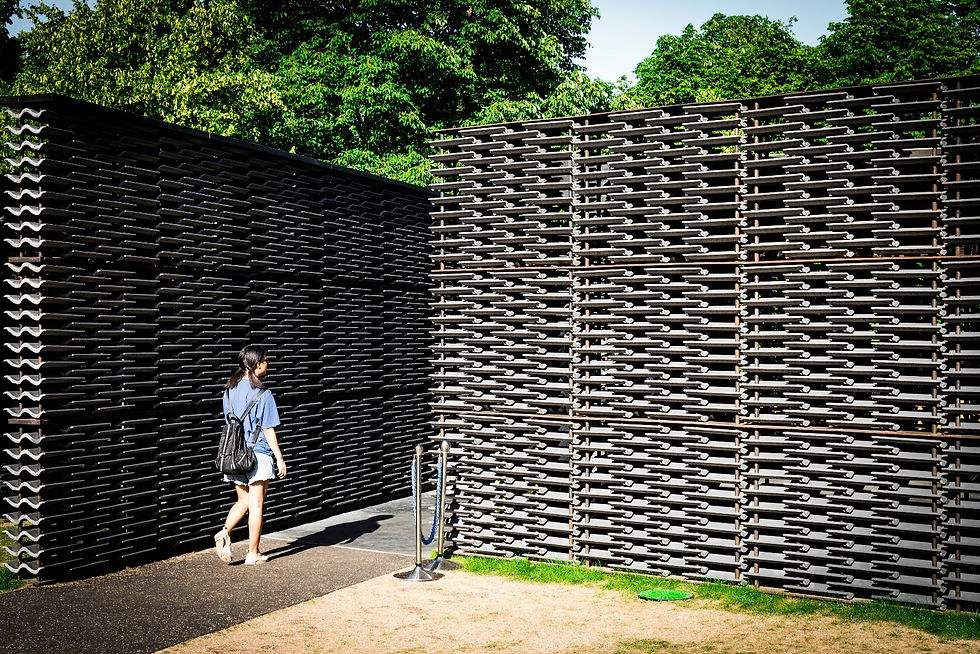SPOTLIGHT: SERPENTINE PAVILION 2018
- Damla T
- Jun 19, 2018
- 3 min read
Serpentine Pavilion 2018 is a dark oasis with echoes of Mexican tradition.

Architect: Frida Escobedo
Location: London, England
Project Availability: 15 June – 7 October 2018
Each year, a new fascinating contemporary design pops up at the heart of the Hyde Park in London, under the name of Serpentine Pavilion. This year, the Serpentine Pavilion was designed by Frida Escobedo, carrying echoes of traditional Mexican architecture within its latticed walls.

What Is the Serpentine Pavilion?
Since 2000, a different architect is invited to design the new pavilion each year, one who has not yet completed a building project in the UK, to showcase a new perspective on today’s contemporary architecture.
Starting with the first ever pavilion by Zaha Hadid, many famous contemporary architects have been chosen to design the pavilion. Among the designers are Daniel Libeskind, Oscar Niemeyer, Rem Koolhaas, Frank Gehry, and Peter Zumthor.
The structure usually stays for 3 months in the park, open to the visitors during the day hours. During this period, various social gatherings take place in the pavilion, all the while contributing to the architectural conversation in today’s design context.
Sepentine Pavilion 2018
This year's design by Frida Escobedo shows the beauty of simplicity in terms of space and materials.

The aim of the architect was to create a site-specific structure that would relate to its current location as well as having the ability to be adapted to its new site after the Serpentine exhibition. As a result, the pavilion was designed as two overlapping rectangular spaces. The first of these is positioned in relation to the Serpentine Gallery and the second in relation to its alignment to the prime meridian.

The structure itself is made of semi-connected walls around a reflecting pool, creating a peaceful and protected inner courtyard. The concept of protected, private inner courtyards is common in the Mexican architectural vernacular.
The walls are a latticework of grey concrete roof tiles supported by a simple steel framework. Inspired by the celosia walls commonly used in Mexico, the tapestry-like walls allow the breeze and daylight to come through while protecting the interior space from high temperatures. In addition, the inner spaces exude a sense of privacy without feeling closed off from its context.
The interior of the structure contains a triangular reflecting pool, allowing a play of light within the walls. The same reflective quality is echoed in the mirrored canopy hanging over central space of the pavilion.


The result is a curious interplay of light and space, alluding to the traditional Mexican architecture of Escobedo’s heritage. However, Mexico was not the only source of inspiration during the design process. She was also inspired by the works of a Russian modernist painter/architect El Lissitzsky, in her approach to experiencing the space in fragments.
The structure also draws spatial parallels with the 2011 design of Serpentine Pavilion by Peter Zumthor in collaboration with Piet Oudolf. Both structures were, in a sense, dark oases formed around a protected heart. However, the choice of materials is what gives each design its unique sense of atmosphere and space.
About the Architect
This year’s featured architect Frida Escobedo (who is 39 years old) is currently the youngest architect commissioned for the creation of the Serpentine Pavilion. She is also the second woman in a long, male-dominated list of architects for this particular project. (The first was, of course, Zaha Hadid.)
One of the founders of Perro Rojo Studio, Escobedo is a Mexican architect, who uses layering and delicate deliberation of simple materials as well as various cultural elements in her designs.
Her previous works include the Casa Negra in Mexico City, La Tallera in Cuernevaca, and installations at the Lisbon Triennial and the V&A museum.
Beautiful materials exist everywhere. Sometimes, beautiful materials are not very sophisticated. – Frida Escobar, in an interview with Frieze

In related news...
The Forbidden Pavilion
For the first time since its conception, there were more than one Serpentine Pavilion this year. The gallery teamed up with WF Central in Beijing to create a second structure in China, within the limits of the Forbidden City. Designed by Jiakun Architects, the new structure is inspired by the shape of an archer’s bow.
The London Mastaba
A short way off from the Serpentine Pavilion, floating on the lake like a giant bath toy, is the bright colored trapezoid structure, designed by Cristo.
Consisting of 7,506 oil drums painted in different tones of blues, reds and pinks, the floating super sculpture is difficult to miss among the green expanse of the Hyde Park.
The intrigued public can be seen photographing or pedaling up close to the 20m tall geometric structure. The response to the artwork seem to be a general confusion, curiosity and humor.
The London Mastaba will be floating on the Serpentine Lake until the end of summer.

For more information:
Official Website for Serpentine Pavilion 2018 (External link)





Comments